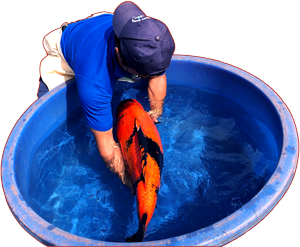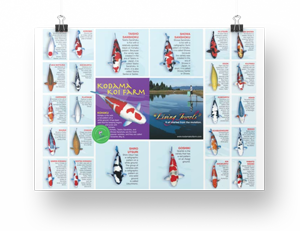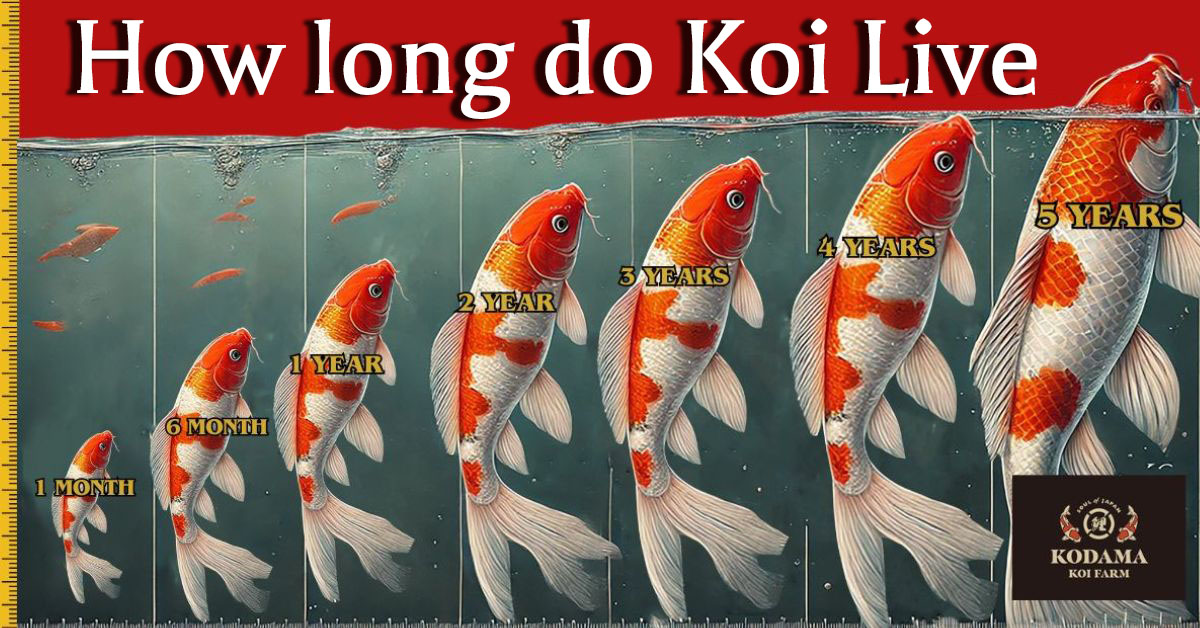
Koi fish aren’t just beautiful additions to your pond – they can become lifelong companions.
The appeal for koi goes far beyond their stunning colors and graceful movements. What makes koi truly special is how they grow with you, becoming a lasting presence and a symbol of harmony, patience, and resilience. This enduring bond is one reason koi are among the most cherished pet fish. Their remarkable longevity creates a connection that can span decades.
On average, koi live between 25 to 35 years, but with exceptional care, many can exceed 50 years. Japanese koi – especially high-quality Nishikigoi – are known to live even longer, with some documented cases surpassing 100 years. The longevity of Nishikigoi is largely due to careful, selective breeding practices refined over generations in Japan. In fact, there are verified cases in Japan of koi living more than 50 years. Imported koi from Japan often exhibit greater hardiness and longer lifespans than their domestically bred counterparts.
Growth Stages and Lifespan of Koi Fish
Koi fish go through distinct growth stages during their lifetime, each with unique care requirements to promote health and longevity. They will grow at different speeds based on water and food quality, this is a good example of what to expect:
Fry Stage (0–3 Months): Newly hatched koi (fry) are fragile and highly vulnerable to predators and water quality issues, so they should be kept in a separate tank with a consistent temperature and high oxygen levels. For feeding, start with powdered fry food and gradually introduce small, high-protein pellets.
Juvenile Stage (3–12 Months): Juvenile koi experience rapid growth and can double in size within months while developing early color patterns. Provide high-protein food (30–40%) to support growth and maintain excellent water quality to prevent stress and disease.
Young Adult Stage (1–3 Years): Koi reach sexual maturity around 2–3 years of age, with a slower growth rate but more defined color patterns. A balanced diet of high-protein and color-enhancing foods supports their development.
Mature Adult Stage (3–10 Years): Adult koi reach their maximum size and develop full color patterns, typically measuring between 20–36 inches depending on genetics and care. A high-quality diet with varied nutrients supports health and color vibrancy.
Senior Stage (10+ Years): Growth slows significantly, and koi may develop signs of aging, such as faded colors and slower swimming. Monitor for joint issues and reduced immune function, adjusting the diet to support slower metabolism and prevent obesity.
With proper care, koi can live 25 to 35 years, or even longer!
During this time, their activity may further decline, and they may need softer foods and even more attentive monitoring for health issues like tumors, swim bladder problems, or digestive concerns. Clean, stable water conditions, reduced stress, and routine health checks are essential to maintaining their quality of life in their golden years.
Understanding each life stage of koi fish helps owners provide tailored care to promote long, healthy lives. From the delicate fry stage to their senior years, adapting diet, habitat, and health management ensures koi thrive for decades, rewarding keepers with their beauty and personality over time.
Why Japanese Koi Live Longer Than Domestic Koi: Genetics, Care, and Lifespan Differences
Several sources indicate that Japanese koi typically have longer lifespans than their domestically bred counterparts. The Smithsonian’s National Zoo notes that koi have an average lifespan of 40 years, with the oldest-known koi living to nearly 230 years. Additionally,
Everything Koi reports that domestic koi have an average lifespan of around 15 years, whereas Japanese koi tend to live much longer, averaging 40 years. Similarly, Iowa Waterscapes mentions that Japanese koi can live between 40 and 60 years, while non-Japanese koi average about 15 years.
These differences in lifespan are often attributed to factors such as genetics, diet, and environmental conditions
Koi fish are admired not only for their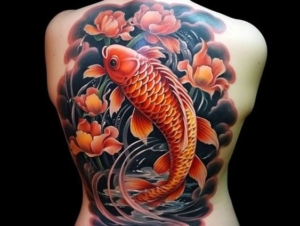 beauty but for their incredible longevity—some living over 50 years with proper care. This endurance mirrors the powerful koi fish meaning strength, resilience, and perseverance through life’s challenges. Just as koi swim upstream, defying the odds, their long lifespan symbolizes the rewards of persistence and inner power. If you’re inspired by the koi’s journey, let it reflect in your tattoo.
beauty but for their incredible longevity—some living over 50 years with proper care. This endurance mirrors the powerful koi fish meaning strength, resilience, and perseverance through life’s challenges. Just as koi swim upstream, defying the odds, their long lifespan symbolizes the rewards of persistence and inner power. If you’re inspired by the koi’s journey, let it reflect in your tattoo.
Discover how koi longevity enhances the koi fish meaning strength in your next tattoo design today!
What Affects a Koi Fish’s Lifespan?
Koi fish are known for their beauty and longevity, with some living for decades under the right conditions. However, their lifespan depends on several key factors, including water quality, diet, genetics, and overall care. Here are some major reasons that affect a koi fish’s lifespan and how you can help them thrive for years to come.
Water Quality & Pond Conditions
- Koi requires clean, oxygen-rich water with a balanced pH (7.0–8.5).
- Filtration systems help remove toxins like ammonia and nitrites.
- Winter care is crucial—frozen ponds without aeration can lead to koi suffocation.
- Regular water testing is essential for maintaining healthy pond conditions. Learn more about pond water quality management.

Diet & Nutrition
- What do koi fish eat for a longer life? A high-protein diet (30-40%) in warm months supports growth.
- Seasonal feeding: Reduce food intake in colder months to prevent digestion issues.
- Choosing the right koi food is key to supporting growth and longevity. Explore more about koi food options.

Genetics & Selective Breeding
- Why do Japanese koi live longer? High-quality koi from reputable breeders have better genetics.
- Domestic koi often have shorter lifespans due to commercial breeding.
- Selecting a trusted breeder ensures healthier koi with stronger genetics. Explore our collection of high-quality koi.
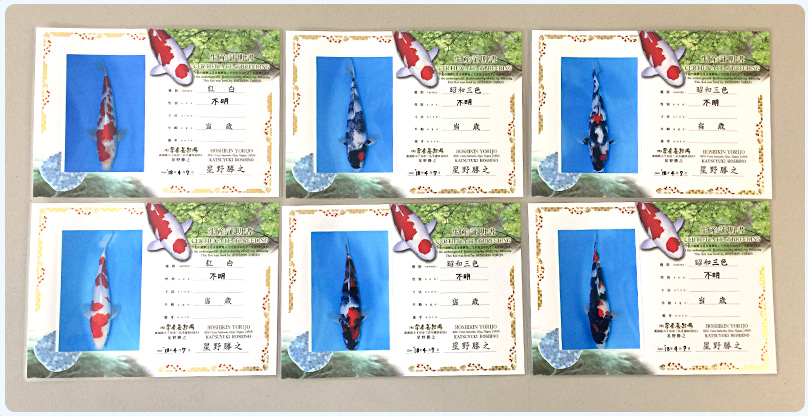
Predators, Stress & Safety
- Outdoor koi are vulnerable to herons, raccoons, and even cats.
- Adding pond netting, deep water areas, and hiding spots can help protect koi.
- Overcrowding causes stress, which can shorten a koi’s lifespan.
- Proper pond maintenance is key to reducing stress and improving koi health. Learn more about maintaining and fixing pond issues.

Disease Prevention & Veterinary Care
- Koi are prone to diseases like Koi Herpes Virus (KHV), Ich, and bacterial infections.
- Quarantine new fish for at least 2-4 weeks before introducing them to your pond.
- Regularly check koi for signs of illness (lethargy, sores, flashing behavior).
- Early diagnosis and treatment are crucial for koi health. Learn more about koi health and disease symptoms.
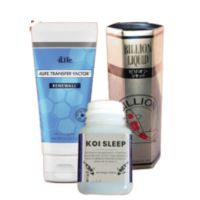
How to Help Your Koi Fish Live Longer
Want your koi to reach 50+ years? Follow these best practices:
✅ Maintain high water quality with proper filtration & aeration.
✅ Feed a nutrient-rich, seasonal diet for optimal health.
✅ Avoid overcrowding—give each koi at least 250 gallons of water.
✅ Protect against predators & environmental stressors.
✅ Monitor for signs of illness and act quickly on treatments.
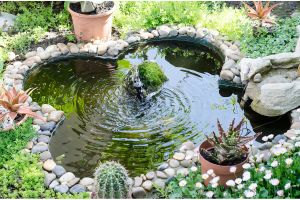
Spring Pond Care for a Longer Koi Lifespan
- Water temperatures rise—begin feeding gradually as koi become more active.
- Check for signs of parasites and infections.
- Clean filters and remove winter debris.
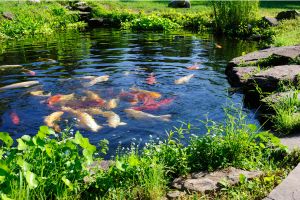
Summer Pond Care for a Longer Koi Lifespan
- Koi enter a dormant state below 50°F.
- Stop feeding at this point to prevent digestive issues.
- Use a pond heater or de-icer to prevent the surface from freezing over completely.

Auitumn Pond Care for a Longer Koi Lifespan
- Reduce feeding as water temperatures drop below 60°F.
- Prepare the pond for winter by cleaning and reinforcing protective netting.
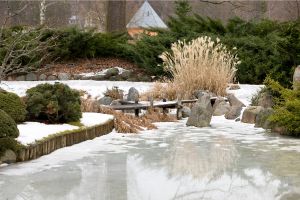
Winter Pond Care for a Longer Koi Lifespan
- Koi enter a dormant state below 50°F
- Stop feeding at this point to prevent digestive issues.
- Use a pond heater or de-icer to prevent the surface from freezing over completely.
FAQs About Koi Fish Lifespan
Q: What is the longest-living koi fish?
A: The oldest known koi, Hanako, lived for 226 years in Japan, thanks to pristine water conditions and proper care.
Q: Do koi live longer in a pond or an aquarium?
A: Koi generally live longer in a pond, where they have more space, better water circulation, and natural sunlight. Indoor koi in small tanks often have shorter lifespans. It is ok, but not preferred to keep koi in an aquarium.
Q: Can koi fish live with goldfish?
A: Yes, but goldfish have shorter lifespans (10-20 years), and koi require larger spaces to thrive.
Q: How do I know if my koi fish is aging?
A: Older koi may show faded colors, slower swimming, and reduced appetite.
Conclusion: Invest in Good Pond Management
Koi fish have the potential for long lifespans, but their longevity depends on proper pond care, nutrition, and disease prevention. If you’re serious about raising koi that live for decades, invest in high-quality fish, maintain excellent water conditions, and stay consistent with care routines. Looking for high-quality koi or expert care tips? Explore our guides or check out trusted koi breeders for the best fish for your pond!
Give Your Koi the Longest, Healthiest Life Possible — Starting Today
Want to help your koi live longer, healthier lives? Discover expert tips on nutrition, water quality, and care from true koi specialists. View Kodama Koi Farm koi for sale to learn how to maximize your koi’s lifespan with proven guidance, high-quality supplies, and decades of Japanese koi-keeping wisdom.
